There are bucket list destinations, and then, there are sights stemming from childhood dreams. For me, the one place I’ve always wanted to visit was the Great Pyramids of Giza, so it was taken for granted that they would be our first stop in Cairo, the national capital of Egypt.
It was an electrifying feeling to finally see that place I’d only imagined or seen in National Geographic.
Here I am, elated, standing in front of Khafre, the one pyramid with some remaining granite casing at the top.  I knew we’d arrived in the Middle East when I spotted these camels as we drove through the sprawling metropolis of Cairo, a bustling city with a population of over 20 million people.
I knew we’d arrived in the Middle East when I spotted these camels as we drove through the sprawling metropolis of Cairo, a bustling city with a population of over 20 million people. I was overjoyed when our accommodation turned out to be a mere 300 meters facing the Sphinx. That evening, from the rooftop, the marvellous and mysterious Pyramids were right there, and with hubby, I gazed in amazement as the sun set over them.
I was overjoyed when our accommodation turned out to be a mere 300 meters facing the Sphinx. That evening, from the rooftop, the marvellous and mysterious Pyramids were right there, and with hubby, I gazed in amazement as the sun set over them.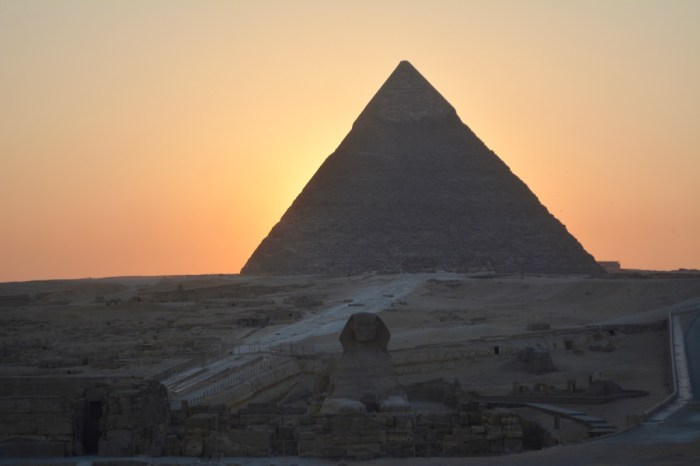
Day 1: Pyramids of Giza and the Sphinx
The next morning, in the company many other visitors, we wandered the grounds of the Giza necropolis, impressed with the burial place and the monuments of the Pharaohs of Egypt.
Gordon standing in awe of the builder’s brilliance of the three main Pyramids from the lookout point on the desert plateau of Giza.  From left to right: Great Pyramid of Khufu, (Cheops), Khafre (Chephren), and Menkaure (Mycerinus).
From left to right: Great Pyramid of Khufu, (Cheops), Khafre (Chephren), and Menkaure (Mycerinus).
How the heck did they build them? Photos just don’t justify the size of these incredible structures, ingenious masonry works of cut limestones and granite.
The largest (Cheops) is comprised of over 2.5 million blocks of stone, weighing 2.5 tonnes on average, and hauled in from a quarry some thirty km away. It is believed to have been built in twenty-eight years. Only Egyptians were allowed to work on the structure, and they did this in the winter season after the field work, and the harvest was complete. Up to 200,000 workers were involved in this massive task. — A puzzle hard to comprehend!
The Great Sphinx was chiselled from a giant single piece of sandstone, from a small hill that obstructed the view of the pyramids on the procession route from the east bank of the Nile. Scholars remain in disagreement which Pharaoh had the Sphinx carved, but all agree that the 73m long, and 20 m high Egyptian king- lion head is a remarkable sculpture.
The Sphinx of Giza, a symbol of ancient Egypt.  We passed on the camel and horse rides into the desert landscape, but their presence added an exotic layer to the setting.
We passed on the camel and horse rides into the desert landscape, but their presence added an exotic layer to the setting.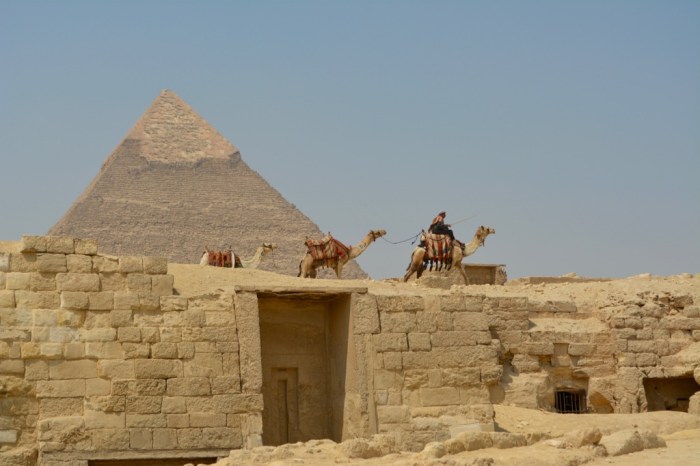 A camel driver taking a break between trips.
A camel driver taking a break between trips.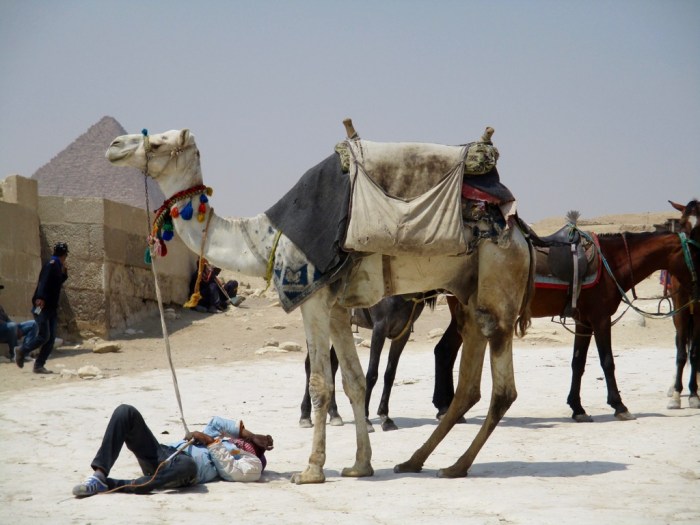
Day 2: Old Cairo and the Egyptian Museum
Cairo is massive, and at the thought of getting around, we rationalised and booked a private car for the day.
We started in Old Cairo, visiting Saints Sergius and Bacchus Church (Abu Serga), the oldest Coptic church in Egypt, dating back to the 4th century. Mary, Joesph and baby Jesus sought refuge in a cave for one month at this location after fleeing the Holy Land. King Herod, upon learning the son of God had been born ordered his troops to kill all male infants under the age of three to eliminate any threat to his leadership. Jesus survived, and Christian history unfolded.

Entrance to the famous Hanging Coptic church in Cairo, dedicated to the Virgin Mary.
Sadly, two days after our visit, as Coptic Christians (Egypt’s Christian minority) celebrated Palm Sunday, suicide bombings by radical Muslims at a Coptic Church north of Cairo killed 25 people and another two in Alexandria.
Our next stop was to the Museum of Egyptian Antiquities, which hosts an extensive collection of Egyptian artefacts, mummies, and a display of the treasures from King Tutankhamun’s tomb.
The collections are extensive, but the condition of the building is suffering from deferred maintenance. Many of the exhibits are out of date and dusty, and in need of a good cleaning. With a bottle of ‘Windex’, I would have the place sparkling.
The museum seemed more of a warehouse in its present condition. Impressive nevertheless.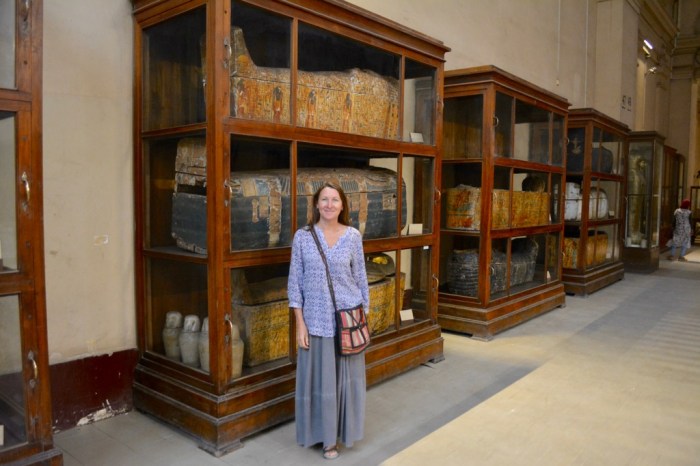

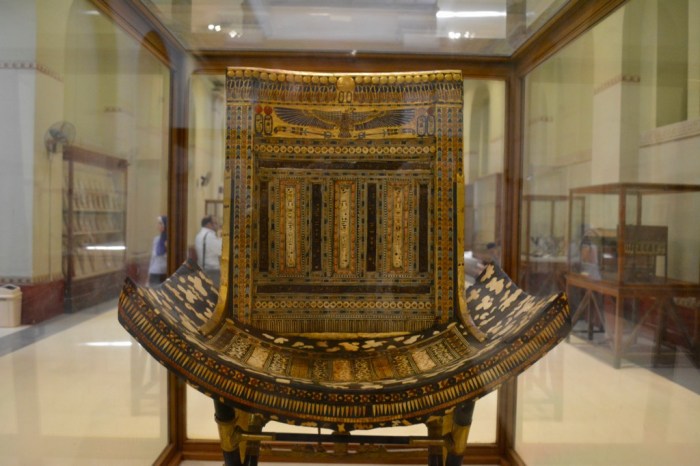 Outside the entrance, these two fragments of the statue of King Psamtek I (ca. 664-610 BC), the first king of the 26th Dynasty represent his torso and his crowned head. They were recently discovered on March 7, 2017, during a road and sewer excavation and were transferred to the museum site a few days later.
Outside the entrance, these two fragments of the statue of King Psamtek I (ca. 664-610 BC), the first king of the 26th Dynasty represent his torso and his crowned head. They were recently discovered on March 7, 2017, during a road and sewer excavation and were transferred to the museum site a few days later.
The statue would have been originally about nine metres in height, making it the largest statue of the Late Period. 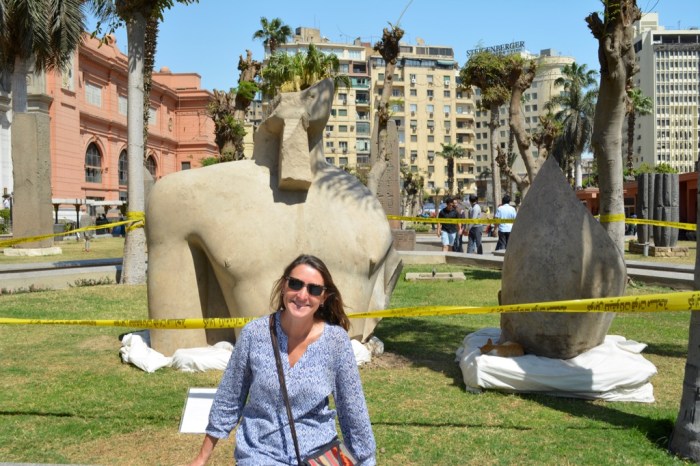 Later in the day, we learned of the ancient Papyrus process, paper made from weaving thin strips of the tall aquatic plant of the Nile Delta and applying pressure. The fibres naturally mesh creating a durable and workable form of paper, one that has been used to record events and the daily lives of the Egyptians for centuries.
Later in the day, we learned of the ancient Papyrus process, paper made from weaving thin strips of the tall aquatic plant of the Nile Delta and applying pressure. The fibres naturally mesh creating a durable and workable form of paper, one that has been used to record events and the daily lives of the Egyptians for centuries.
A demonstration on the making of Papyrus.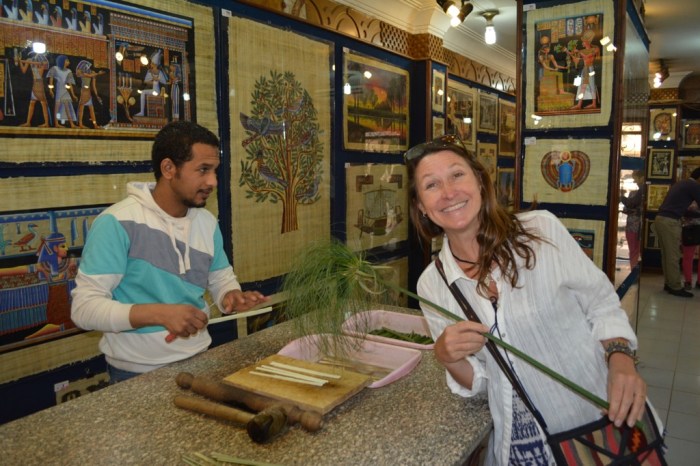 After an enjoyable day in Cairo, we retreated back to and our rooftop terrace, and later still, we were fortunate to watch the Pyramid Sound and Light Show; a narrated history lesson, with accompanying music and coloured lights illuminating the pyramids.
After an enjoyable day in Cairo, we retreated back to and our rooftop terrace, and later still, we were fortunate to watch the Pyramid Sound and Light Show; a narrated history lesson, with accompanying music and coloured lights illuminating the pyramids. Cairo was nothing short of a childhood dream come true! – Ginette
Cairo was nothing short of a childhood dream come true! – Ginette





On my bucket list as well Ginette. Loved to see it through your eyes….one day I will get there!
Sue, I have a few destinations on my bucket list where you’ve been. The more I travel, the longer the list seems to get…how is that? For now, I’m enjoying the journey and the adventure. I’m certain you will get to see the ancient pyramids. We are fortunate! – Ginette
Cool to read about your “short stop” in Egypt.
I only had 26 hours myself but loved every minute !
(My marathon here if you’re curious https://upsidedowntravels.com/2017/01/16/weekend-getaway-giza-pyramids/ )